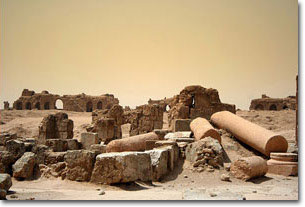|
 The
nearest main town is Raqqa, 200 km south east of Aleppo. Although
associated essentially with Byzantines, the site of Resafe was
mentioned in earlier sources, both in Assyrian texts and in the Bible.
The Roman Emperor, Diocletian (ruled 284 – 305 AD) established here a
frontier fortress to meet the Sassanian threat. The Strata Diocletiana,
named after the Emperor, ran from Sura (on the Euphrates) via Resafe
south to Palmyra and on to Damascus via Dumeir. The
nearest main town is Raqqa, 200 km south east of Aleppo. Although
associated essentially with Byzantines, the site of Resafe was
mentioned in earlier sources, both in Assyrian texts and in the Bible.
The Roman Emperor, Diocletian (ruled 284 – 305 AD) established here a
frontier fortress to meet the Sassanian threat. The Strata Diocletiana,
named after the Emperor, ran from Sura (on the Euphrates) via Resafe
south to Palmyra and on to Damascus via Dumeir.
For the Byzantines, the original settlement of Resafe took on a new
importance with the growth of the cult of St. Sergius. A Roman soldier
serving as a court official, Sergius was martyred here during
Diocletian's persecution in 305 after refusing to sacrifice to Jupiter.
His cult attracted followers from throughout Syria. The town's
amenities were considerably expanded under the Byzantine Emperor,
Anastasias I who officially renamed the city Sergiopolis in honor of
its patron saint. A large basilica was constructed and a cistern and
ramparts provided. 
The 6th century brought a new and more persistent Persian threat. The
town became a new focal point of Justinian's great program of military
works in Syria towards the end of his reign 527 – 65. Slightly before
the rebuilding of the great fortress of Halebiye, the walls of Resafe
were reconstructed; stone replaced mud-brick and a new art of military
architecture was introduced. Persians penetrated the screen several times in the 6th century.
Sergiopolis held out against the Persian raids but with great
difficulty, notably during the campaigns of Chosroes I. Later it fell
to Chosroes II in his campaign of 616 which did so much fatally to
weaken Byzantine control of Syria, softening it up for the Arab
invasion two decades later. Under the Umayyad Resafe was for a time favored by the Caliph Hisham
(ruled 724 – 43) who restored its facilities and erected a palace.
After the Abbasid conquest in 750, it suffered the vengeance of the new
regime's troops who destroyed Hisham's tomb in the city. 
The Northern Gate The city is laid out in a huge rectangle approximately 550 m by 400 m.
This gate is slightly juts out of the wall, a single outer entrance
(now gone) sheltering a rectangular court whose inner triple gateway
with its rich outer gateway had been crossed. The central passage is
flanked by two side doors decorated with friezes. The Centralized Church The basic basilica shape of the three naves is broken up by the clever
use of curves to bend outwards the inner and outer rectangles. Three
arcaded semi-circles expand the inner area; while the rear and side
outer walls are gently taken out to accommodate them. The eastern end
of the church adopts the familiar Byzantine design of a central apse
with semi-circular seating flanked by two square side chapels. The Basilica Church of St Sergius This was the focal point of the religious pilgrimage in the last
decades of the Byzantine period. The basic plan is basilica-shaped: two
side aisles are separated from the central nave by three enormous
semi-circular arches resting on cross-shaped piers. There are also many other remains; the cisterns, the palace of Hisham,
the Turkish caravanserai and praetorium (palace) of the Ghassanid
period. |


